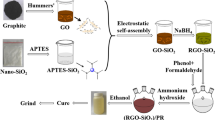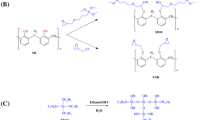Abstract
Phenolic resin (PR) modified with hybrids of reduced graphene oxide (RGO)-encapsulated nano-SiO2 (SiO2–RGO) was prepared by a simple method. The synergistic effect of RGO and nano-SiO2 was achieved in the thermal decomposition of the modified PR. Thermal stability of SiO2–RGO and the modified PR was evaluated by thermogravimetric analysis (TG). With 1 mass% loading of SiO2–RGO, the maximum decomposition temperature (Tdmax) of the modified PR was increased by 32.50 °C and the residual mass at 800 °C was increased by 6.54%. The structure of the resin char was characterized to study the mechanism of ameliorative thermal stability. SiO2–RGO hybrids were conducive to induce the PR to form graphitized carbon in the pyrolysis process. Thus, SiO2–RGO can facilitate the application of PR in the fields of heat insulation and ablation resistance.














Similar content being viewed by others
References
Bafekrpour E, Simon GP, Yang C, Chipara M, Habsuda J, Fox B. A novel carbon nanofibre/phenolic nanocomposite coated polymer system for tailoring thermal behaviour. Compos Part A Appl Sci. 2013;46(1):80–8.
Kim M, Choe J, Dai GL. Development of the fire-retardant sandwich structure using an aramid/glass hybrid composite and a phenolic foam-filled honeycomb. Compos Struct. 2016;158:227–34.
Ebrahimi H, Roghani-Mamaqani H, Salami-Kalajahi M. Preparation of carbon nanotube-containing hybrid composites from epoxy, novolac, and epoxidized novolac resins using sol–gel method. J Therm Anal Calorim. 2018;132:513–24.
Song SA, Lee Y, Kim YS, Kim SS. Mechanical and thermal properties of carbon foam derived from phenolic foam reinforced with composite particles. Compos Struct. 2017;173:1–8.
Choe J, Kim M, Kim J, Dai GL. A microwave foaming method for fabricating glass fiber reinforced phenolic foam. Compos Struct. 2016;152:239–46.
Li S, Chen F, Zhang B, Luo Z, Li H, Zhao T. Structure and improved thermal stability of phenolic resin containing silicon and boron elements. Polym Degrad Stab. 2016;133:321–9.
Chen Y, Hong C, Chen P. The effects of zirconium diboride particles on the ablation performance of carbon–phenolic composites under an oxyacetylene flame. RSC Adv. 2013;3(33):13734–9.
Asaro L, D’Amico DA, Alvarez VA, Rodriguez ES, Manfredi LB. Impact of different nanoparticles on the thermal degradation kinetics of phenolic resin nanocomposites. J Therm Anal Calorim. 2017;128:1463–78.
Li C, Qi S, Zhang D. Thermal degradation of environmentally friendly phenolic resin/Al2O3 hybrid composite. J Appl Polym Sci. 2010;115(6):3675–9.
Amirsardari Z, Aghdam RM, Salavati-Niasari M, Shakhesi S. Enhanced thermal resistance of GO/C/phenolic nanocomposite by introducing ZrB2, nanoparticles. Compos Part B Eng. 2015;76(21):174–9.
Sang HY, Kim SH, Lee WI, Kim H. Improvement of ablation resistance of phenolic composites reinforced with low concentrations of carbon nanotubes. Compos Sci Technol. 2015;121:16–24.
Nair S, Aswathy UV, Mathew A, Raghavan R. Studies on the thermal properties of silicone polymer based thermal protection systems for space applications. J Therm Anal Calorim. 2016;128:1731–41.
Srikanth I, Daniel A, Kumar S, Padmavathi N, Singh V, Ghosal P. Nano silica modified carbon–phenolic composites for enhanced ablation resistance. Mater Scr. 2010;63(2):200–3.
Periadurai T, Vijayakumar CT, Balasubramanian M. Thermal decomposition and flame retardant behaviour of SiO2-phenolic nanocomposite. J Anal Appl Pyrolysis. 2010;89:244–9.
Bao C, Guo Y, Yuan B, Hu Y, Song L. Functionalized graphene oxide for fire safety applications of polymers: a combination of condensed phase flame retardant strategies. J Mater Chem. 2012;22(43):23057–63.
Wang H, Hao Q, Yang X, Lu L, Wang X. Effect of graphene oxide on the properties of its composite with polyaniline. ACS Appl Mater Interface. 2010;2(3):821–8.
Si J, Li J, Wang S, Li Y, Jing X. Enhanced thermal resistance of phenolic resin composites at low loading of graphene oxide. Compos Part A Appl Sci. 2013;54(4):166–72.
Wang D, Gao J, Xu WF, Bao F, Ma R, Yan CJ. The synthesis and characterization of the graphene oxide covalent modified phenolic resin nanocomposites. Adv Mater Res. 2011;327(327):115–9.
Noparvar-Qarebagh A, Roghani-Mamaqani H, Salami-Kalajahi M. Novolac phenolic resin and graphene aerogel organic-inorganic nanohybrids: high carbon yields by resin modification and its incorporation into aerogel network. Polym Degrad Stab. 2015;124:1–14.
Liao SH, Liu PL, Hsiao MC, Teng CC, Wang CA, Ger MD. One-step reduction and functionalization of graphene oxide with phosphorus-based compound to produce flame-retardant epoxy nanocomposite. Eng Chem Res. 2012;51(12):4573–81.
Zhang Z, Yuan L, Guan Q, Liang G, Gu A. Synergistically building flame retarding thermosetting composites with high toughness and thermal stability through unique phosphorus and silicone hybridized graphene oxide. Compos Part A Appl Sci. 2017;98:174–83.
Chen J, Zhao D, Jin X, Wang C, Wang D, Ge H. Modifying glass fibers with graphene oxide: towards high-performance polymer composites. Compos Sci Technol. 2014;97:41–5.
Stöber W, Fink A, Bohn E. Controlled growth of monodisperse silica spheres in the micron size range. J Colloid Interface Sci. 1968;26(1):62–9.
Chen J, Wu J, Ge H, Zhao D, Liu C, Hong X. Reduced graphene oxide deposited carbon fiber reinforced polymer composites for electromagnetic interference shielding. Compos Part A Appl Sci. 2016;82:141–50.
Yang S, Feng X, Ivanovici S, Müllen K. Fabrication of graphene-encapsulated oxide nanoparticles: towards high-performance anode materials for lithium storage. Angew Chem. 2010;49(45):8408.
Chen J, Zhao D, Ge H, Wang J. Graphene oxide-deposited carbon fiber/cement composites for electromagnetic interference shielding application. Constr Build Mater. 2015;84:66–72.
Reich S, Thomsen C. Raman spectroscopy of graphite. Philos Trans. 1842;2004(362):2271–88.
Zalan Z, Lazar L, Fulop F. Chemistry of hydrazinoalcohols and their heterocyclic derivatives. Part 1. Synthesis of hydrazinoalcohols. Curr Org Chem. 2005;36(31):357–76.
Ren PG, Yan DX, Ji X, Chen T, Li ZM. Temperature dependence of graphene oxide reduced by hydrazine hydrate. Nat Nanotechnol. 2011;22(5):055705.
Noparvar-Qarebagh A, Roghani-Mamaqani H, Salami-Kalajahi M, Kariminejad B. Nanohybrids of novolac phenolic resin and carbon nanotube-containing silica network. J Therm Anal Calorim. 2016;128(2):1027–37.
Abdolmaleki A, Mallakpour S, Karshenas A. Facile synthesis of glucose-functionalized reduced graphene oxide (GFRGO)/poly(vinyl alcohol) nanocomposites for improving thermal and mechanical properties. Mater Sci Eng B Sold. 2017;217:26–35.
Kim YJ, Kim MI, Yun CH, Chang JY, Park CR, Inagaki M. Comparative study of carbon dioxide and nitrogen atmospheric effects on the chemical structure changes during pyrolysis of phenol-formaldehyde spheres. J Colloid Interface Sci. 2004;274(2):555–62.
Park JM, Kwon DJ, Wang ZJ, Gu GY, Devries KL. Interfacial, fire retardancy, and thermal stability evaluation of graphite oxide (GO)-phenolic composites with different GO particle sizes. Compos Part B Eng. 2013;53(5):290–6.
Blanco M, Vazquez A, Gabilondo N. Curing characteristics of resol-layered silicate nanocomposites. Thermochim Acta. 2007;467(1):73–9.
KříStková M, Filip P, Weiss Z, Peter R. Influence of metals on the phenol–formaldehyde resin degradation in friction composites. Polym Degrad Stab. 2004;84(1):49–60.
Lin CT, Lee HT, Chen JK. Preparation and properties of bisphenol-F based boron-phenolic resin/modified silicon nitride composites and their usage as binders for grinding wheels. Appl Surf Sci. 2015;330:1–9.
Huang L, Zhu P, Li G, Lu D, Sun R, Wong C. Core–shell SiO2@RGO hybrids for epoxy composites with low percolation threshold and enhanced thermo-mechanical properties. J Mater Chem A. 2014;2(43):18246–55.
Acknowledgements
This work is supported by the Foundation for the Youth Science and Technology Innovation of Beijing Composite Materials Co., Ltd., and A Project of Shandong Province Higher Educational Science and Technology Program (Grant No. J14LA05).
Author information
Authors and Affiliations
Corresponding author
Rights and permissions
About this article
Cite this article
Chen, J., Zhang, W., Liu, J. et al. Improved thermal stability of phenolic resin by graphene-encapsulated nano-SiO2 hybrids. J Therm Anal Calorim 135, 2377–2387 (2019). https://doi.org/10.1007/s10973-018-7325-5
Received:
Accepted:
Published:
Issue Date:
DOI: https://doi.org/10.1007/s10973-018-7325-5




